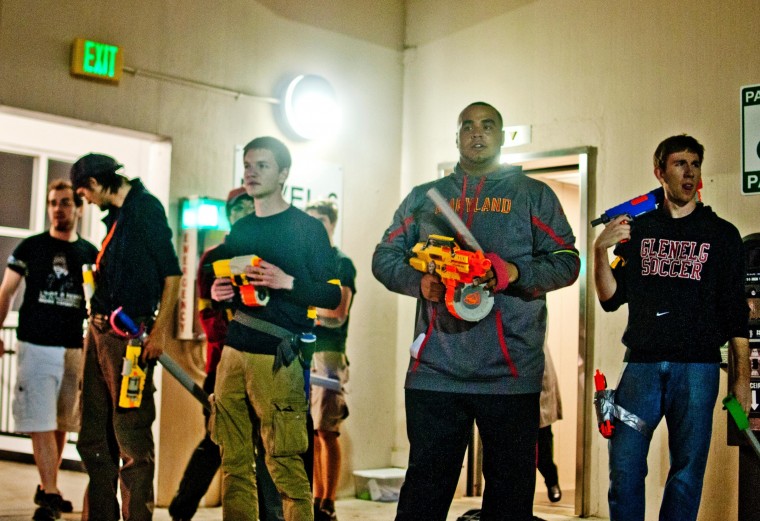
On April 16, the UMD Nerf Activity Society began a two-week long game of Humans vs. Zombies. Saturday, the zombies claimed victory on McKeldin Mall.
Between Night and Day, a standoff.
The humans had held rank for more than a half hour, 14 strong and standing in a circle, backs to each other. Many wielded small, semi-automatic weapons. Some had swords. One had a hatchet. One had a machine gun.
Just a few feet away, in the shadow of H.J. Patterson Hall, zombies were putting together a plan of attack. Nothing, to that point, had been working. And, for the next 90 minutes, barely anything would.
It was eight days into Humans vs. Zombies, a two- week long semesterly game put on by the UMD Nerf Activity Society in which a group of students, most of whom readily admit they’re nerds, brandish various Nerf weapons and chase each other around the campus. In the game, which began April 16, the humans have to try to stay alive; the zombies have to hunt for brains.
In the circle between the Night and Day sculptures – two stone statues that sit between Holzapfel Hall and H.J. Patterson – orange, black and yellow darts littered the ground, and an uneasiness gripped the human formation.
Suddenly, an ambush.
About a dozen zombies poured out from behind a bush on the southwest side of the circle, some quiet, beelining for their human of choice, some yelling, charging with abandon.
A flurry of darts, an orgy of plastic clicks and staccato shouts of “got you!” Then, quiet.
“Did we even get one?” a zombie asked.
They didn’t. The zombies retreated to the bushes, but they weren’t dissuaded. There would be plenty more fully armed battalion of humans, plenty of chances to let the world melt away and the inner children inside everyone take charge.
DAY 1
At the beginning, pickings were slim.
At 11 a.m., Sarah Dagen, the Alpha Zed – the original zombie chosen by moderators and charged with amassing an undead army – trailed freshman Tyler Albers from the physics building all the way up to North Campus and attacked him by the computer and space sciences building. Albers shot her with a Nerf gun, stunning her.
Dagen stood with her arms above her head, counting. Albers thought the stun time was five minutes, leaving him with plenty of time to talk to Dagen before he could run away. But he was wrong; he didn’t know the rules well enough.
After two minutes, Dagen lunged at him and grabbed his arm above his yellow armband. He became the Beta Zed, the first human Dagen turned into a zombie.
Dagen had been hunting humans since 7:30 a.m. that morning. She wouldn’t retire until 12 hours later.
—–
Since Humans vs. Zombies came to the campus in fall 2006, reception hasn’t always been kind. For every student who prizes the escapism of the game as a way to truly let loose in college, there are plenty who view the game with skepticism or, sometimes, outright revulsion.
“That’s just not normal,” said Melissa Kahn, a junior psychology major, who one day found herself face to face with a screaming zombie about to charge. A few days ago, she said, she saw a group of players carrying Nerf guns and thought the campus was under attack.
In fall 2008, University Police shut down the game after less than a week when the department received a call from a professor who said he saw a man walking around carrying a real gun. It turned out to be an HvZ player with a Nerf gun.
Now, Danny Michaelis, the group’s president, corresponds with police to let officers know when the game will take place to avoid such problems. This semester, things went smoothly.
That doesn’t change some students’ perceptions, though.
During a scenario, as Terps linebacker A.J. Francis and Andrew Stefany, a freshman computer science major, stealthily moved around Comcast Center, a girl on a scooter saw the football player wielding a massive, automatic blaster called the Stampede.
“Are you kidding me A.J.?” she called out.
“You know it,” he said. He grinned and kept jogging.
DAY 5
Shane Walker is so good at this game that he has become notorious – a mythological character in a post-apocalyptic scenario. He was part of the spring 2010 humans team, the only squad of humans to ever win in six years of Humans vs. Zombies. It was his first semester playing.
Some people say that while dual-wielding his blasters, he can reload using only his hips, like some sort of Wild West gunslinger. In reality, he can’t.
“I don’t know why they keep making these dumb legends,” he said.
But still, the junior classics major embraces it and understands that, for all his notoriety, he still is one of the best players on the campus. He looks like someone who should be hunting zombies, with his thin sunglasses, fingerless leather gloves and a shoulder-length ponytail. He wears two armbands instead of one, doubling the chances of a zombie turning him. He does it as a favor to them, to even the odds.
At noon on day five, he called Marut Tangtrongwanit, a sophomore geography and geographic information science major and recent undead conversion, and told him to get a few zombies to camp outside the North Campus Diner. He was on his way, and he wanted to hunt. When he got there, he climbed over a brick ledge and hid behind a dumpster near Ellicott Hall.
Sitting outside the diner was Tangtrongwanit; a small and exceedingly quick zombie, Josh Clark, who had been turned into a zombie on day one; and the Alpha Zed herself, Dagen.
“Speak of the devil,” Dagen said as Walker revealed himself.
“And the devil will come,” Walker answered, without missing a beat.
The three zombies got up and began to triangulate a position. Walker kept his two blasters outstretched, trying to see everything at once.
They charged. Walker found a slight opening among the three of them and backed through it, carefully aiming and firing. He hit Dagen and Clark without missing. When Tangtrongwanit came at him, darting with his hands down at his sides, trying his best to run in a snake-like pattern, Walker missed once but put him down before he was within striking distance.
And like that, it was over. The three zombies put their hands on their heads and began mentally counting while Walker – the man who calls himself “the king” – reloaded. Dagen sang the praises of the pistachio milkshake she had just picked up from The Diner.
The zombies began to stir again, and Walker put them down again without much trouble. He went inside the diner to get a hamburger. For now, he had survived.
But the zombies’ ranks were growing. After the first scenario the day before, Dagen estimated they had grown to about 30.
The infection was spreading.
—–
The average Nerf dart is about 1 inch long and 1 ounce heavy. It’s made mostly of foam, a material so light and inconsequential you can rip it in two without much effort. It’s tipped with rubber, which keeps its aim true. Sometimes the dart is bright yellow with a bright purple tip; sometimes it’s bright orange with a bright orange tip.
It leaves the blaster with a lame click, the sound of a spring pushing forward, the sound of a simple plastic machine doing a simple machine’s work.
Sometimes, when a dart softly thwacks a zombie, the zombie barely even registers the hit. But the zombie will still immobilize, resigned and frustrated, with hands atop his or her head for a full two minutes.
A Nerf dart is absolutely harmless.
A Nerf dart is absolutely terrifying.
—–
Ultimately, people play Humans vs. Zombies because it’s fun. It’s fun to let the kid inside you run around. It’s just fun.
But why this game? Why Humans vs. Zombies? Why not, say, Cowboys vs. Indians?
“It really is that zombies strike a nerve with us because they are, in my opinion, the quintessential postmodern monster,” said Matt Mogk, the head of the Zombie Research Society, which is made up of doctors who construct biological theories for how zombies might exist. “They are the monster for our time.”
That’s because, as Mogk said, there’s nothing supernatural about zombies – essentially, they’re a virus with legs and teeth. A century ago, when an influenza pandemic wiped out between 20 and 40 million people, scientists didn’t have microscopes powerful enough to see the bug. There was no way for them to know how people were dying, and there was a perverse romance to the unknown.
But now, Mogk said, the average college student knows more about the spread of disease and infection than top scientists in 1918 did. Nowadays, we’re scared of what we understand, not what we don’t, he said.
“We don’t believe in the bogeyman anymore,” said Mogk, who has written three books on zombies and appeared as a panelist on AMC’s Talking Dead. “There’s no more romance in the modern world because there’s nothing left to discover.”
So Humans vs. Zombies, for all the fun of running around, mirrors the spread of an infectious disease. The game was created at Goucher College in 2005.
There’s a reason the game began so recently.
“The challenge is not really for the humans to win,” said Kent Norman, a psychology professor at this university who studies immersion in video games. “It’s like Tetris. You never win Tetris. It’s how long you survive before you get crushed.”
DAY 9
In the afternoon, Walker, the king, was zombified by a group outside of McKeldin Library. It was a surprise, an anticlimax – as Walker finished dispatching zombies and went for the door, another zombie jumped out from inside the lobby and attacked him – but it was enough.
It sent a message: You may be one of the best, but there are always more zombies. They will always come toward you, unceasing, undaunted. The infection will spread. There is no escape.
—–
That night’s events ended in a succession of firefights atop the Mowatt Lane Parking Garage. It ended with humans shooting through the partitions between floors of the garage, with zombies hiding behind cars, with Francis wielding his huge automatic weapon and surviving.
It also ended with a lot of turns. Michaelis, at this point a zombie for a long while, figured there were about 50 humans left.
“We have full confidence the humans are going to lose now,” he said afterward. “It’s just going to happen.
“The final’s going to be devastating.”
DAY 13 – THE FINAL
“Humans, raise your hands!” Sifrit yelled from atop the sundial’s ledge.
Nearly 40 players responded.
“Don’t get used to it,” he said, confident all the humans would soon be zombies. “Soon you’ll be doing this.”
He outstretched his arms in the classic zombie pose. And he was right.
—–
A march. A dispersion.
At 9:30 p.m., four squads of humans set off from the engineering fields in different directions, each with a specific, convoluted set of objectives. A moderator led each group, attempting to bring them to a specific spot without getting massacred.
But when the zombies would come, the humans would be diverted; and then on the run; and then they would reluctantly split from each other; and then they would be turned; and their numbers would dwindle and eventually they would hide, terrified of facing a giant horde of zombies as the rain pounded down late Saturday night.
—–
A small group of humans stood with their backs to Shoemaker Hall, cautiously inching along, weapons outstretched, as an ever-larger group of zombies came toward them. They took off. One human was caught immediately.
The fight moved to the Memorial Chapel fields, the humans slowly backing away and fending off zombies with flurries of darts and melee weapons. But when facing down so many zombies, it’s hard to run. They kept coming.
Suddenly, cries of “MEDIC!”
A zombie fell on a pathway and skinned her palm and knee. Play stopped. The hazy veneer of gameplay fell by the wayside as another player tended to her. She was a bit dazed, but OK.
“Resume in 10 seconds!” Sifrit shouted. Then: “Five! Four! Three! Two! One!”
More than a dozen zombies, who had congregated in wait, flooded over a small set of stairs after the humans. They turned a few. Another few got away.
Meanwhile, on the other side of the campus, two of the four human squads were annihilated.
—–
“I’m really in the dark of how much they’ve done so far,” said Albers, the Beta Zed, wondering how much the humans had accomplished.
He was one of three scouts employed by the zombies. If he came across of a group of humans, he’d call in an army. At this point, he was patrolling the area at the top of McKeldin Mall.
By Hornbake Plaza, he found some humans, along with a small group of zombies on their tail.
“Keep ’em running, keep ’em running!” yelled another zombie.
The group, as it turned out, boasted a few of the game’s most elite players, some of whom were alumni coming back to relive the thrill of past years.
A few years ago, the group called themselves The Sundial Strikers and won the entire game for the humans; it was the only time that ever happened.
This year, they traveled with balloons tied to their backs to make themselves more visible to zombies. They called themselves Ballooner Eclipse.
The zombies cornered one of the members of Ballooner Eclipse, though, in front of the Biology-Psychology building, and turned him into a zombie. He popped his balloon in resignation.
—–
At 10:15 p.m., two dozen zombies waited for a bloodbath at the engineering fields. They had heard there were two small groups of humans left and knew they’d have to come down that way to complete their next objective.
Time passed, and no one showed up. An hour later, when the rain was coming down in harder and harder spurts, the zombies were becoming disillusioned. It’s hard to mentally commit to the game when you’re just standing around, waiting.
“They’re hiding,” Michaelis said about the humans. “They’re scared.”
At 11:30, p.m., Michaelis began to frantically field phone calls from remaining humans. He threatened to call the entire game by midnight if they didn’t show themselves.
But then he found out one moderator had mistakenly bypassed one of the scenario’s steps and had avoided the engineering fields entirely. They were off to the mall to complete their penultimate task: building and activating a game of Mouse Trap.
“All the zeds to the mall!” Dagen screamed, windmilling her arms like a third base coach.
—–
On the mall, chaos.
The humans had split into sub-groups and ran toward the mall from different directions. There were no more than 15, and the zombies chased whomever they could find. More than 70 people running, slipping in the rain-slicked grass, grabbing arms, yelling and yelling and yelling.
It was three minutes to midnight. A human dropped the game of Mouse Trap, which his group was supposed to build. He was turned, and four zombies guarded the box. No one would get close again.
A group of eight humans stood back to back and slowly moved east on the mall, but eventually they were broken up and turned into zombies.
The mall was alight with movement, and the humans were falling quick.
After five minutes, all were dead except for four or five, three of whom were members of Ballooner Eclipse. The writing, for all intents and purposes, was on the wall. The zombies were about to win again.
“Oh, God,” Walker said. He looked up to the sky. More than 40 zombies took off after the remaining humans. The precipitation intensified. “It’s raining darts.”
jwolper@umdbk.com



